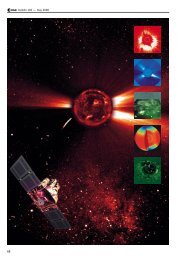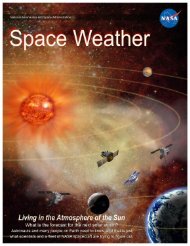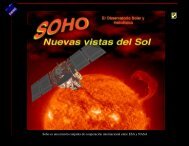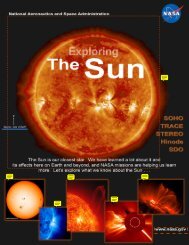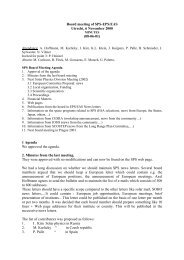10 Years of SOHO - Nasa
10 Years of SOHO - Nasa
10 Years of SOHO - Nasa
- No tags were found...
You also want an ePaper? Increase the reach of your titles
YUMPU automatically turns print PDFs into web optimized ePapers that Google loves.
<strong>SOHO</strong>Perihelion passage <strong>of</strong> comet NEAT (C/2002 V1) in February2003, as imaged by LASCO C32–<strong>10</strong>0 (depending on wavelength) overthe solar cycle. Detailed knowledge <strong>of</strong>the solar spectral irradiance is crucial forunderstanding climate variability, and todisentangle natural variations fromanthropogenic climate changes.<strong>SOHO</strong>, the Comet Finder<strong>SOHO</strong> is providing new measurements notonly about the Sun. On 5 August 2005,Toni Scarmato, a high school teacher fromCalabria, Italy, discovered <strong>SOHO</strong>’s 999thand <strong>10</strong>00th comets. As <strong>of</strong> February 2006,LASCO had detected over 1<strong>10</strong>0 comets,most <strong>of</strong> them ‘Sun-grazers’. These cometspass very close to the Sun and growprominent tails as their icy cores areheated. Nearly half <strong>of</strong> all comets forwhich orbital elements have beendetermined (since 1761) were discoveredby <strong>SOHO</strong>, and over two-thirds <strong>of</strong> thoseby amateurs accessing LASCO data viathe Web. This is a field where amateurscan actively contribute to scientificresearch; each day, numerous peoplefrom all over the world download thenear-realtime data to search for newcomets.As the brightest, most spectacularcomet ever observed by <strong>SOHO</strong>, cometNEAT (C/2002 V1) provided someenticing data for further study, thanks toa grazing encounter with a coronal massejection. The LASCO C3 observationsduring 16–20 February 2003 suggestinteraction between the comet’s ion tailand other magnetic fields in the outercorona at the time <strong>of</strong> the oblique impactwith the CME. This is the first time thatsuch an event has been imaged, and nocomet has ever been observed closer tothe Sun.The analysis <strong>of</strong> high-resolution spectroscopicobservations <strong>of</strong> comet C/2002 X5(Kudo-Fujikawa) from UVCS has revealeda near-spherical cloud <strong>of</strong> neutral hydrogenand a variable tail <strong>of</strong> ionised carbon (C +and C + 2) that disconnected from the cometand was subsequently regenerated.<strong>SOHO</strong>’s SWAN instrument monitoredthe break-up <strong>of</strong> comet LINEAR C/1999S4. The total amount <strong>of</strong> water vapourobserved by SWAN from 25 May to12 August 2000 was estimated at3.3 million tonnes. Only about 1% <strong>of</strong> thiswas left on 6 August, when observationsby the Hubble Space Telescope <strong>of</strong> thedying comet’s fragments gave an estimate<strong>of</strong> the total volume. Combining thenumbers gives a remarkably low value forthe density: about 15 kg/m 3 , comparedwith 917 kg/m 3 for familiar non-porousice. Even allowing for an equal amount <strong>of</strong>dust grains, 30 kg/m 3 is far less than the500 kg/m 3 <strong>of</strong>ten assumed by cometscientists.Conclusions and <strong>SOHO</strong>’s FutureThe journey has not always been easy. Forexample, an unexpected loss <strong>of</strong> contactoccurred on 25 June 1998. Fortunately, themission was completely recovered in one<strong>of</strong> the most dramatic rescue efforts inspace, and normal operations could beresumed in mid-November 1998 after thesuccessful recommissioning <strong>of</strong> thespacecraft and all 12 instruments. Despitethe subsequent failures <strong>of</strong> all threegyroscopes (the last in December 1998),new gyroless control s<strong>of</strong>tware installed byFebruary 1999 allowed <strong>SOHO</strong> to return tonormal scientific operations, providing anwww.esa.int esa bulletin 126 - may 2006 31



